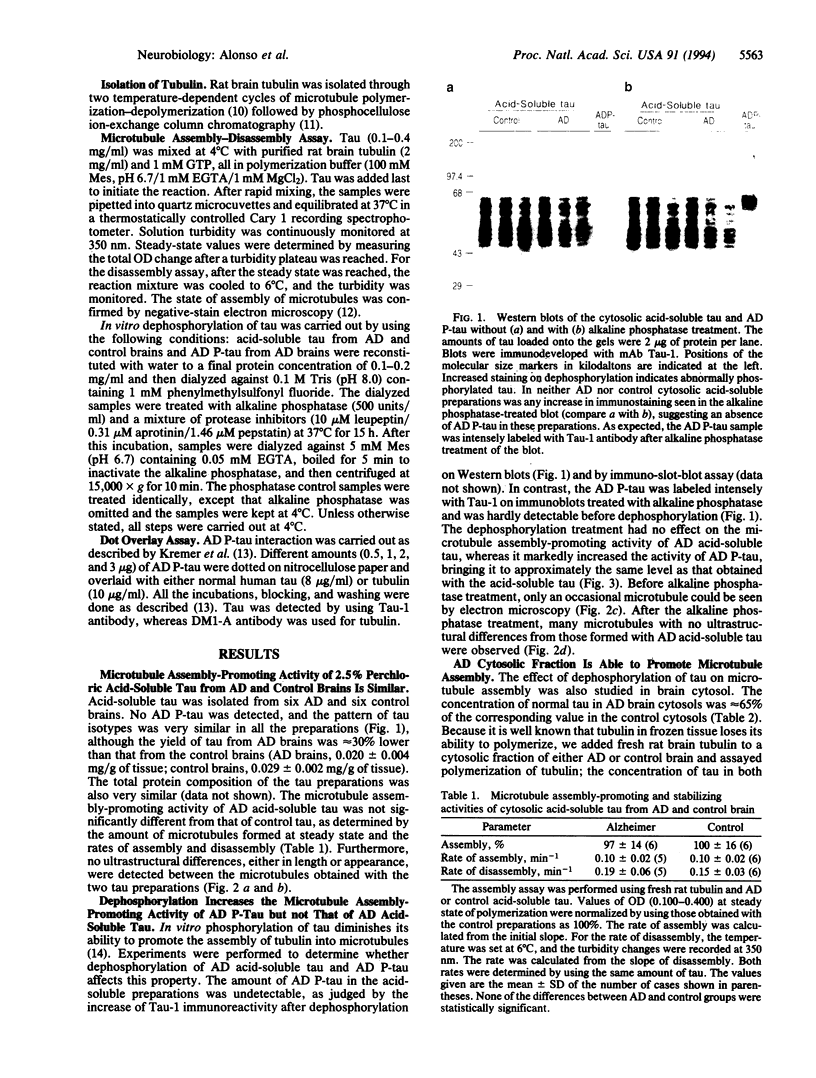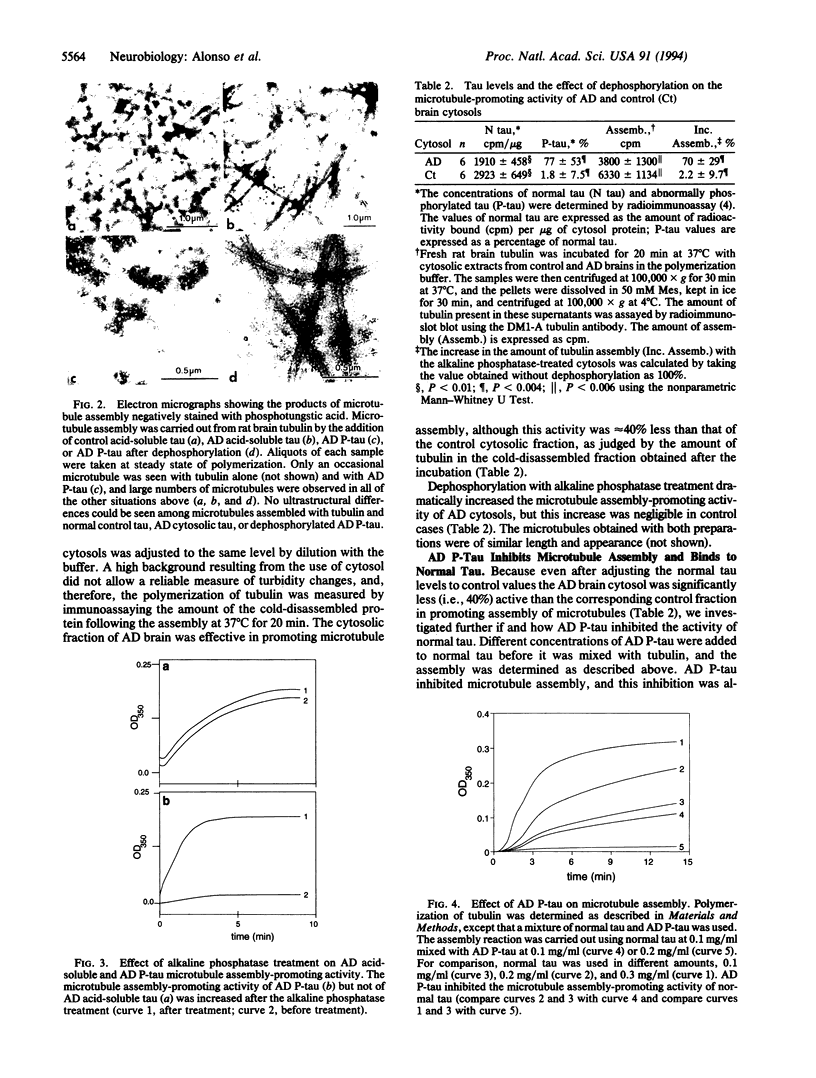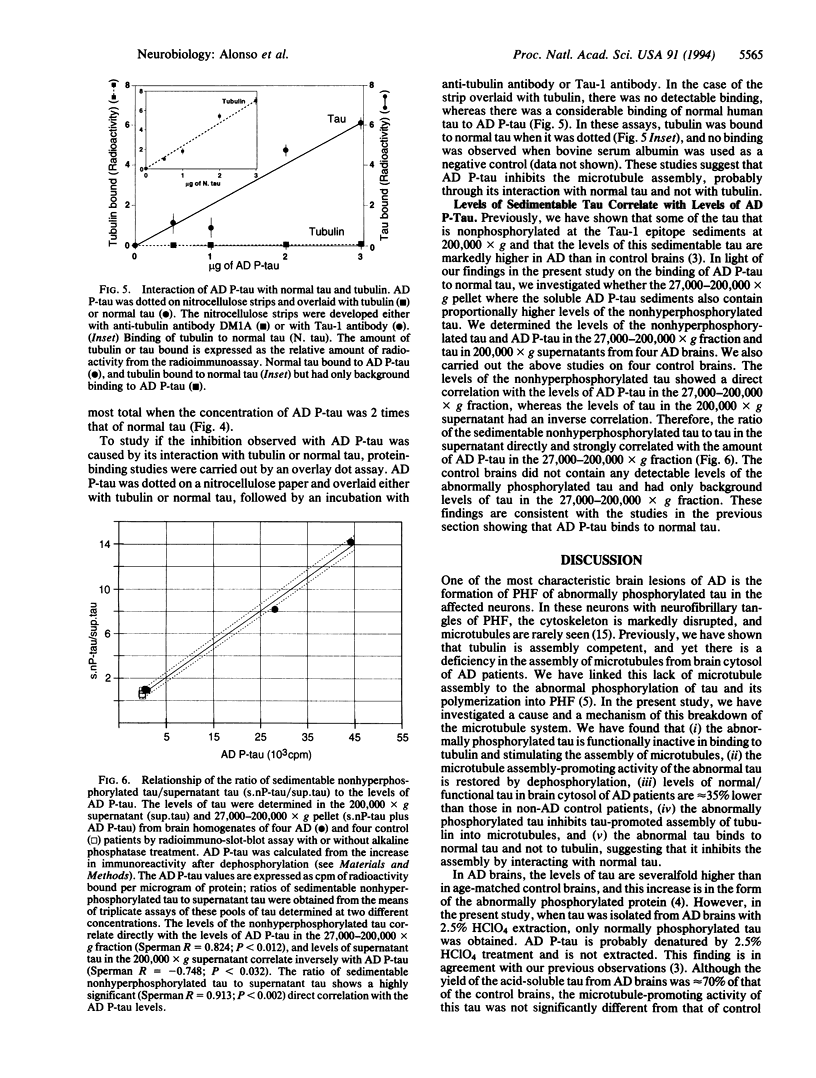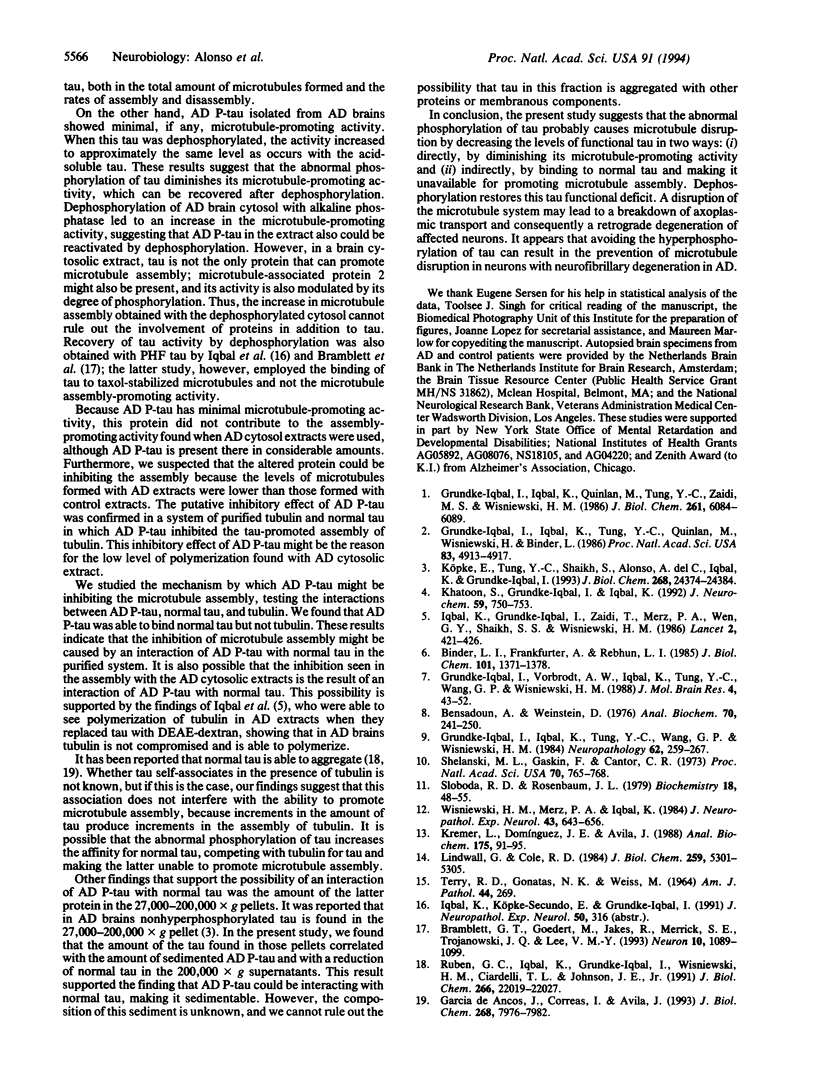Abstract
The microtubule assembly-promoting activity of different pools of tau protein isolated from Alzheimer disease (AD) and control brains and the effect of dephosphorylation on this activity were studied. Tau isolated from a 2.5% perchloric extract of AD brain had almost the same activity as that obtained from control brain, and this activity did not change significantly on dephosphorylation. Abnormally phosphorylated tau (AD P-tau) isolated from brain homogenate of AD patients had little activity, and upon dephosphorylation with alkaline phosphatase, its activity increased to approximately the same level as the acid-soluble tau. Addition of AD P-tau to a mixture of normal tau and tubulin inhibited microtubule assembly. AD P-tau bound to normal tau but not to tubulin. These studies suggest that the abnormal phosphorylation of tau might be responsible for the breakdown of microtubules in affected neurons in AD not only because the altered protein has little microtubule-promoting activity but also because it interacts with normal tau, making the latter unavailable for promoting the assembly of tubulin into microtubules.
Full text
PDF




Images in this article
Selected References
These references are in PubMed. This may not be the complete list of references from this article.
- Bensadoun A., Weinstein D. Assay of proteins in the presence of interfering materials. Anal Biochem. 1976 Jan;70(1):241–250. doi: 10.1016/s0003-2697(76)80064-4. [DOI] [PubMed] [Google Scholar]
- Binder L. I., Frankfurter A., Rebhun L. I. The distribution of tau in the mammalian central nervous system. J Cell Biol. 1985 Oct;101(4):1371–1378. doi: 10.1083/jcb.101.4.1371. [DOI] [PMC free article] [PubMed] [Google Scholar]
- Bramblett G. T., Goedert M., Jakes R., Merrick S. E., Trojanowski J. Q., Lee V. M. Abnormal tau phosphorylation at Ser396 in Alzheimer's disease recapitulates development and contributes to reduced microtubule binding. Neuron. 1993 Jun;10(6):1089–1099. doi: 10.1016/0896-6273(93)90057-x. [DOI] [PubMed] [Google Scholar]
- García de Ancos J., Correas I., Avila J. Differences in microtubule binding and self-association abilities of bovine brain tau isoforms. J Biol Chem. 1993 Apr 15;268(11):7976–7982. [PubMed] [Google Scholar]
- Grundke-Iqbal I., Iqbal K., Quinlan M., Tung Y. C., Zaidi M. S., Wisniewski H. M. Microtubule-associated protein tau. A component of Alzheimer paired helical filaments. J Biol Chem. 1986 May 5;261(13):6084–6089. [PubMed] [Google Scholar]
- Grundke-Iqbal I., Iqbal K., Tung Y. C., Quinlan M., Wisniewski H. M., Binder L. I. Abnormal phosphorylation of the microtubule-associated protein tau (tau) in Alzheimer cytoskeletal pathology. Proc Natl Acad Sci U S A. 1986 Jul;83(13):4913–4917. doi: 10.1073/pnas.83.13.4913. [DOI] [PMC free article] [PubMed] [Google Scholar]
- Grundke-Iqbal I., Iqbal K., Tung Y. C., Wisniewski H. M. Alzheimer paired helical filaments: immunochemical identification of polypeptides. Acta Neuropathol. 1984;62(4):259–267. doi: 10.1007/BF00687607. [DOI] [PubMed] [Google Scholar]
- Grundke-Iqbal I., Vorbrodt A. W., Iqbal K., Tung Y. C., Wang G. P., Wisniewski H. M. Microtubule-associated polypeptides tau are altered in Alzheimer paired helical filaments. Brain Res. 1988 Aug;464(1):43–52. doi: 10.1016/0169-328x(88)90017-4. [DOI] [PubMed] [Google Scholar]
- Iqbal K., Grundke-Iqbal I., Zaidi T., Merz P. A., Wen G. Y., Shaikh S. S., Wisniewski H. M., Alafuzoff I., Winblad B. Defective brain microtubule assembly in Alzheimer's disease. Lancet. 1986 Aug 23;2(8504):421–426. doi: 10.1016/s0140-6736(86)92134-3. [DOI] [PubMed] [Google Scholar]
- Khatoon S., Grundke-Iqbal I., Iqbal K. Brain levels of microtubule-associated protein tau are elevated in Alzheimer's disease: a radioimmuno-slot-blot assay for nanograms of the protein. J Neurochem. 1992 Aug;59(2):750–753. doi: 10.1111/j.1471-4159.1992.tb09432.x. [DOI] [PubMed] [Google Scholar]
- Kremer L., Domínguez J. E., Avila J. Detection of tubulin-binding proteins by an overlay assay. Anal Biochem. 1988 Nov 15;175(1):91–95. doi: 10.1016/0003-2697(88)90365-x. [DOI] [PubMed] [Google Scholar]
- Köpke E., Tung Y. C., Shaikh S., Alonso A. C., Iqbal K., Grundke-Iqbal I. Microtubule-associated protein tau. Abnormal phosphorylation of a non-paired helical filament pool in Alzheimer disease. J Biol Chem. 1993 Nov 15;268(32):24374–24384. [PubMed] [Google Scholar]
- Lindwall G., Cole R. D. Phosphorylation affects the ability of tau protein to promote microtubule assembly. J Biol Chem. 1984 Apr 25;259(8):5301–5305. [PubMed] [Google Scholar]
- Ruben G. C., Iqbal K., Grundke-Iqbal I., Wisniewski H. M., Ciardelli T. L., Johnson J. E., Jr The microtubule-associated protein tau forms a triple-stranded left-hand helical polymer. J Biol Chem. 1991 Nov 15;266(32):22019–22027. [PubMed] [Google Scholar]
- Shelanski M. L., Gaskin F., Cantor C. R. Microtubule assembly in the absence of added nucleotides. Proc Natl Acad Sci U S A. 1973 Mar;70(3):765–768. doi: 10.1073/pnas.70.3.765. [DOI] [PMC free article] [PubMed] [Google Scholar]
- Sloboda R. D., Rosenbaum J. L. Decoration and stabilization of intact, smooth-walled microtubules with microtubule-associated proteins. Biochemistry. 1979 Jan 9;18(1):48–55. doi: 10.1021/bi00568a008. [DOI] [PubMed] [Google Scholar]
- TERRY R. D., GONATAS N. K., WEISS M. ULTRASTRUCTURAL STUDIES IN ALZHEIMER'S PRESENILE DEMENTIA. Am J Pathol. 1964 Feb;44:269–297. [PMC free article] [PubMed] [Google Scholar]
- Wisniewski H. M., Merz P. A., Iqbal K. Ultrastructure of paired helical filaments of Alzheimer's neurofibrillary tangle. J Neuropathol Exp Neurol. 1984 Nov;43(6):643–656. doi: 10.1097/00005072-198411000-00008. [DOI] [PubMed] [Google Scholar]




